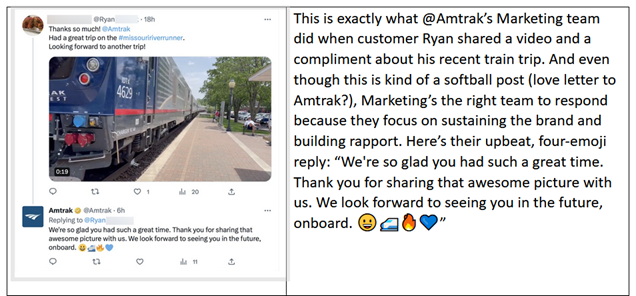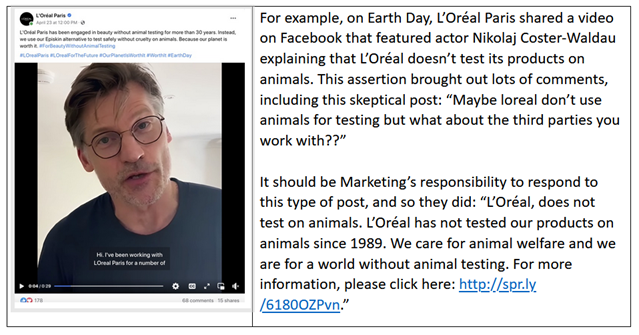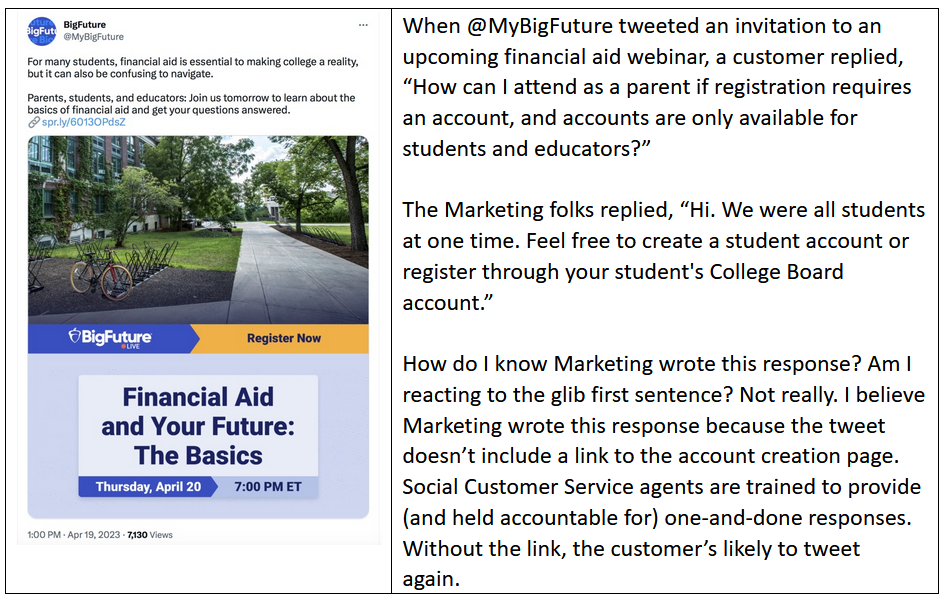By
Leslie O'Flahavan
|
Date Published: May 24, 2023 - Last Updated July 12, 2023
|
Comments
I’m not sure whether it’s a turf battle, a sibling rivalry, or a custody fight, but whatever is going on between the Customer Service Team and the Marketing Team is hurting customers who reach out for help via social media.
Granted, social channels are unpredictable. If you’re a shoe retailer and your Marketing Team posts on Instagram about a back-to-school sale, some angry customer is going to comment, “I bought some boots online and paid for overnight shipping, but they arrived 10 days later. You need to refund my shipping fees on order #12345!!” And all of a sudden, what was just a BOGO sales post is now a customer service contact.
Companies provide better service in these unpredictable social channels when Customer Service owns the responsibility of responding to customers’ complaints. Marketing shouldn’t respond to complaints; that’s not their job or skillset. And Marketing shouldn’t just forward service-related social posts over to Customer Service because unhappy customers get lost in the shuffle. Marketing should respond to some types of customer comments in social, but Customer Service should take the lead on customers’ questions or complaints.
Marketing should respond to customers’ “I love this brand” social posts
Until a social post becomes a complaint, Marketing should respond, not Customer Service. So every time a passenger tweets out a pouty photo of themselves sporting a new shade of lipstick, the makeup manufacturer’s Marketing team should reply with something like “Wow, you look stunning in that red lip! 💄👄”

Marketing should respond to customers’ “I hate this brand” social posts
Social media channels draw a company’s critics. People flock to social channels to share their outrage when the CEO says something political, a product gets recalled, or a spokesperson steps out of line. Responding to these posts is the Marketing team’s responsibility; they collaborate with the PR team, the Comms team, and other appropriate teams to develop an on-brand message for these hot-topic posts. Customer Service should be able to ignore these posts entirely. Defending the brand is not Customer Service’s responsibility.
For example, on Earth Day, L’Oréal Paris shared a video on Facebook that featured actor Nikolaj Coster-Waldau explaining that L’Oréal doesn’t test its products on animals. This assertion brought out lots of comments, including this skeptical post: “Maybe loreal don’t use animals for testing but what about the third parties you work with??”

It can be painfully obvious when Marketing tries to do Customer Service’s job
The Marketing Team lacks access to customers’ accounts and purchase history, they don’t know the systems that enable shipping, refunds, or upgrades, and they don’t have a first contact resolution mindset. And boy, can their lack of customer service savvy be obvious when they do respond to customers in social media. Here’s an example. The College Board’s “BigFuture” is “…a free online planning guide that helps all students take the right first step after high school.”

A non-answer in social is a sign that Marketing may own the channel
It’s a customer service best practice to answer the customer’s question in the channel it was asked. And while agents occasionally ask customers, “Can I call you, so I can learn more about what you need?”, most Customer Service organizations strive to serve customers in whichever channel they’ve used to start the conversation. But when Marketing owns social media, it has to send customers elsewhere to get answers, and that makes for a lousy customer experience.

A dedicated Customer Service handle can help make sharing the channel easier
Because a brand’s main Twitter handle will contain varied conversations, some companies use a dedicated @help handle for Customer Service. Though a dedicated handle can’t prevent customer service questions from popping up in the main brand handle, it can make the handoff to the @help handle seem purposeful.

Social channels can be gossipy, passionate, trivial, profane, and playful. Marketing loves those intense conversations. But social media is also businesslike, transactional, info-seeking, responsive, and practical. Customer Service is great at all that. While the two teams may share an investment in social media, Customer Service should answer all social posts that include practical questions or solvable complaints. We’re Customer Service. We serve. That’s what we do!